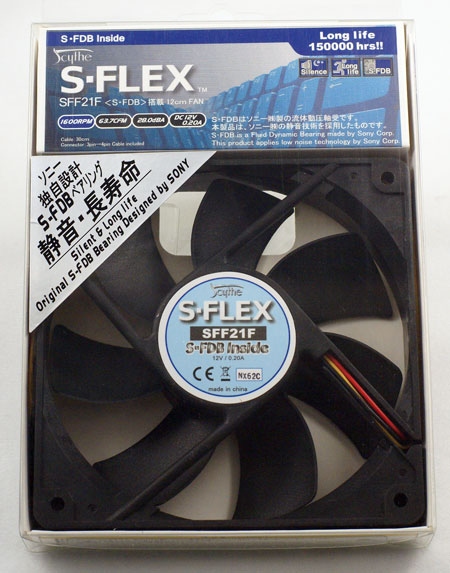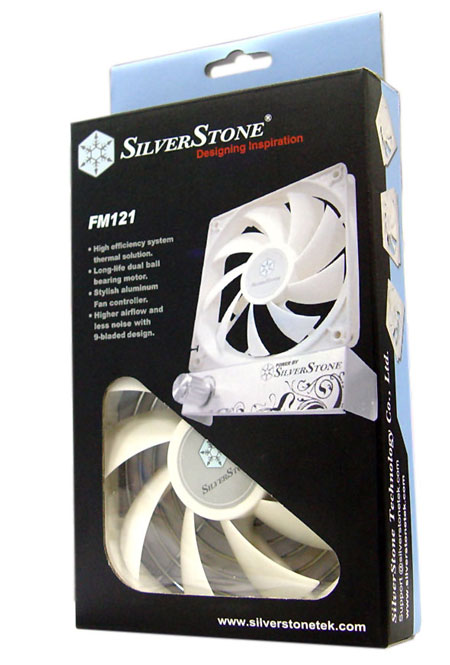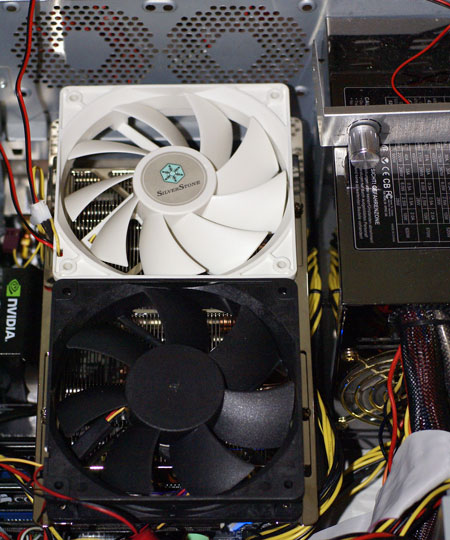Cooler Master GeminII: Performer or Poser?
by Wesley Fink on April 30, 2007 2:00 AM EST- Posted in
- Cases/Cooling/PSUs
Fan Configurations
While the Cooler Master GeminII does not ship with a cooling fan, the capability of mounting two 120mm fans on the cooler opens many possibilities. You can choose high-output fans for maximum airflow and theoretically the best performance, or you can choose two ultra-low noise fans for extremely quiet operation, or you can choose a combination of the two, such as a high output over the CPU and a silent fan over the memory area.
Since there are so many possibilities testing was performed with several configurations to assess the impact of different fan configurations on performance and noise with the Gemini II cooler.

We first tested with Scythe SFLEX SFF12F fans, which exhibit relatively low noise and high output. Two SFLEX fans were used, with each fan specified as 63.7CFM and 1600RPM at 28 dB-A.
The cooling is better than the stock Intel retail cooler and the overclocking extends a bit further at 3.83GHz compared to the 3.73GHz of the Intel retail cooler. However, these results with two fans do not really challenge any of the top coolers tested in cooling or overclocking ability.
One Scythe SFLEX was then swapped for the Silverstone FM121. This 9-bladed fan has variable output from 800RPM to 2400RPM. At 2400RPM output is an amazing 110.03CFM with noise at a less than silent 39.5 dB-A.

With the variable output you can choose silence and low output at 800RPM/17 dB-A, or you can go with noise and very high output at 2400RPM/39.5 dB-A, as well as all values in between. We tested cooling efficiency and noise with the Scythe SFLEX at full speed and the Silverstone FM121 at both 2400RPM and 800RPM.

It was amazing that the huge difference in fan output between the 800RPM and 2400RPM settings makes very little difference in overall performance of the GeminII. While temperatures were a 0C to 4C cooler with the high output fan at 2400RPM, the GeminII could still only reach a stable overclock of 3.85GHz. This compares to the better coolers with this CPU reaching 3.90GHz to 3.94GHz. Even more surprising was the fact that the low noise setting on the Silverstone FM121 combined with a quiet Scythe SFLEX still managed to reach a top overclock of 3.83GHz. This is just slightly less than the high output setting which also was exhibiting noise greater than 50 dB-A.
Finally the Cooler Master GeminII was equipped with two of the outstanding low-noise Noctua NF-S12 fans.

At standard voltage these fans are specified at 1200RPM with output at 50CFM and 17 dB-A. Lowering voltage with the U.L.N.A. reduces fan speed to 800RPM and noise to 8 dB-A. The pair of Noctua fans was run at full speeds with the pair of fans providing 100CFM of airflow on the Gemini II.
While cooling was 1C to 4C less than the super high output 110CFM fan, noise remained below the system noise floor with the pair of Noctua fans. Perhaps even more impressive was that we still managed to reach a stable 3.83GHz overclock - the same as all the other fan configurations except for the high output. The high output allowed an OC to 3.85GHz, which is just 20MHz more and hardly relevant.
It was concluded from testing four different fan configurations that the overclock limit for the Gemini II is around 3.83GHz, regardless of the fan configuration. This is certainly better than the stock Intel 3.73GHz, but it is far from the 3.9GHz to 3.94GHz we have reached in overclocks of the top coolers tested at AnandTech. The GeminII performance is below average for a top cooler and a disappointment.
If you do plan to use a GeminII in your system choose moderate output, low-noise fans for cooling. You might be tempted to use high output and super-high output fans in an effort to reach the best cooling possible, but the higher output fans make little difference on this cooler. High output fans dramatically increase noise - especially when using two with this cooler - but they do not improve performance very much.
While the Cooler Master GeminII does not ship with a cooling fan, the capability of mounting two 120mm fans on the cooler opens many possibilities. You can choose high-output fans for maximum airflow and theoretically the best performance, or you can choose two ultra-low noise fans for extremely quiet operation, or you can choose a combination of the two, such as a high output over the CPU and a silent fan over the memory area.
Since there are so many possibilities testing was performed with several configurations to assess the impact of different fan configurations on performance and noise with the Gemini II cooler.

We first tested with Scythe SFLEX SFF12F fans, which exhibit relatively low noise and high output. Two SFLEX fans were used, with each fan specified as 63.7CFM and 1600RPM at 28 dB-A.
| Dual Scythe SFLEX SFF21F | |||
| 2.93GHz | 3.73GHz | 3.83GHz | |
| Idle | 30 | 38 | 43 |
| Load | 41 | 54 | 58 |
The cooling is better than the stock Intel retail cooler and the overclocking extends a bit further at 3.83GHz compared to the 3.73GHz of the Intel retail cooler. However, these results with two fans do not really challenge any of the top coolers tested in cooling or overclocking ability.
One Scythe SFLEX was then swapped for the Silverstone FM121. This 9-bladed fan has variable output from 800RPM to 2400RPM. At 2400RPM output is an amazing 110.03CFM with noise at a less than silent 39.5 dB-A.

With the variable output you can choose silence and low output at 800RPM/17 dB-A, or you can go with noise and very high output at 2400RPM/39.5 dB-A, as well as all values in between. We tested cooling efficiency and noise with the Scythe SFLEX at full speed and the Silverstone FM121 at both 2400RPM and 800RPM.
| Silverstone FM121@2400RPM + Scythe SFLEX SFF21F | |||
| 2.93GHz | 3.73GHz | 3.85GHz | |
| Idle | 30 | 36 | 41 |
| Load | 38 | 50 | 56 |

| Silverstone FM121@800RPM + Scythe SFLEX SFF21F | |||
| 2.93GHz | 3.73GHz | 3.83GHz | |
| Idle | 33 | 38 | 41 |
| Load | 39 | 54 | 58 |
It was amazing that the huge difference in fan output between the 800RPM and 2400RPM settings makes very little difference in overall performance of the GeminII. While temperatures were a 0C to 4C cooler with the high output fan at 2400RPM, the GeminII could still only reach a stable overclock of 3.85GHz. This compares to the better coolers with this CPU reaching 3.90GHz to 3.94GHz. Even more surprising was the fact that the low noise setting on the Silverstone FM121 combined with a quiet Scythe SFLEX still managed to reach a top overclock of 3.83GHz. This is just slightly less than the high output setting which also was exhibiting noise greater than 50 dB-A.
Finally the Cooler Master GeminII was equipped with two of the outstanding low-noise Noctua NF-S12 fans.

At standard voltage these fans are specified at 1200RPM with output at 50CFM and 17 dB-A. Lowering voltage with the U.L.N.A. reduces fan speed to 800RPM and noise to 8 dB-A. The pair of Noctua fans was run at full speeds with the pair of fans providing 100CFM of airflow on the Gemini II.
| Dual Noctua NF-S12 | |||
| 2.93GHz | 3.73GHz | 3.83GHz | |
| Idle | 30 | 39 | 43 |
| Load | 39 | 54 | 58 |
While cooling was 1C to 4C less than the super high output 110CFM fan, noise remained below the system noise floor with the pair of Noctua fans. Perhaps even more impressive was that we still managed to reach a stable 3.83GHz overclock - the same as all the other fan configurations except for the high output. The high output allowed an OC to 3.85GHz, which is just 20MHz more and hardly relevant.
It was concluded from testing four different fan configurations that the overclock limit for the Gemini II is around 3.83GHz, regardless of the fan configuration. This is certainly better than the stock Intel 3.73GHz, but it is far from the 3.9GHz to 3.94GHz we have reached in overclocks of the top coolers tested at AnandTech. The GeminII performance is below average for a top cooler and a disappointment.
If you do plan to use a GeminII in your system choose moderate output, low-noise fans for cooling. You might be tempted to use high output and super-high output fans in an effort to reach the best cooling possible, but the higher output fans make little difference on this cooler. High output fans dramatically increase noise - especially when using two with this cooler - but they do not improve performance very much.










44 Comments
View All Comments
Cableaddict - Thursday, June 5, 2008 - link
This review ranks with Anantech's H2O kit review as one of the all-time low points for internet reviews.Once again, accurate & useful data marred by horrendous conclusions.
To wit:
1: Some people have small cases, like HTPC cases & such, and cannot fit any of the top heatsinks. For all of these users, the Gemini II is quite possibly the BEST heatsink that will actually fit. (It will JUST fit into a 3U rack case, with Noctua fans installed)
2: Some people care about low noise. The Gemini II was shown, by this very review, to excel with low-noise fans. Compare any heatsink made, with the possibly exception of the Ultra-120, to the Gemini with both using 1300 rpm Noctuas- The Gemini is the clear winner.
----
But sadly, the reviewer here fails to take these situations into consideration and decides to say that the excellent Gemini II is a "poser." Because this review was the first major one to be published, no one else really bothered much, and the product all but disappeared from the marketplace.
SHAME on this reviewer. Seriously.
FWIW, I had a DuOrb on my OC'd Q6600. I couldn't get it past 3.2 Ghz.
I recently switched to a Gemini II with two Noctuas, and have reached 3.5 Ghz under heavy load. - And the noise is almost non-existant.
This review blows.
Patrick Wolf - Monday, January 24, 2011 - link
Exactly. Obviously this cooler isn't targeted or designed to compete against the big boys. So to say it's a poser is just plain ignorant.mrseew - Thursday, December 13, 2007 - link
was looking for a review on the gemini ii vs the 120, thanksFarfle - Tuesday, October 2, 2007 - link
I got this cooler for $1 buck after rebates from Newegg. I don't care if it doesn't cool any better than the Intel HSF; the box and metal itself are worth the $1 just to look at. They're so shiny!!!Uglystick - Wednesday, September 19, 2007 - link
I dont mind AT comparing one product agianst another in fact I welcome it as it gives me a better feel on how the product fits into the market. But I find this review a little lacking. It reviews the coolers ability to cool but states the it comes midrange in all the tests of all aircoolers tested, but i could not find any mention of how much the cooler cost in comparison to the leading performers. A little investigation of the AT site shows that the "TOP" performer costs almost double what the Gemini (the Thermalright Ultra 120 is shown as $60 and the Gemini at $33) wouldnt this indicate that the cooler is not "meant" to compete with the top line models, after all we dont compare the family sedan with a Porsche do we. There's no mention of value for $ anywhere in the article (unless i missed it) so it may not be the great cooler that you were hoping it to be but how does it compare when you bring budget and market placement into it.Samus - Tuesday, September 4, 2007 - link
you never mentioned that memory and northbridge temperatures fall off the map with the gemini IIthe purpose of the cooler isn't to be an exceptional cpu cooler. its purpose is to cool everything else, too. and it does THAT better than ANY other cooler out there. my memory and northbridge have no active cooling, so with this cooler, they run exceptionally cooler. and all at no expense to added noise.
jes1111 - Wednesday, May 16, 2007 - link
Wow! Seems some people (including the reviewer) got out of bed on the wrong side.In common with many people, when I'm in the market for a new oiece of kit, I google up as many reviews and forum posts as I can find and make purchasing decisions accordingly. I find it significant that of all the reviews for the CoolerMaster Gemini II, yours is the only negative one. This tells me a lot about your approach.
The fact is that the vast majority of readers/surfers/PC-owners are NOT looking to "OC this rig to 5.9GHz at 27,000 volts on air!" just so they can brag about it at playschool. And as a good and responsible review site, you shouldn't be pandering to these measurebators.
I find your conclusion misleading and even unfair to CoolerMaster. The Gemini fits a particular need, a niche requirement if you will, and your review should reflect that instead of dismissing it as a gimmick that fails to outperform XYZ brand.
Take my case: I have a Gigabyte DQ6 board in a Lian-Li PC-V2000 Plus II case. I've gone for a mild overclock to 3.2GHz (400x8) with the RAM running at 1:1 (800). Originally I fitted a Noctua big-tower cooler thingee. The CPU cooling was just great but I was running an uncomfortably high temp on the MCH (a common problem with tower-style coolers). Problem: on this board (and many others I'm), a tower-style cooler of the Noctua's dimensions overhangs the MCH, so I'm unable to fit a 40mm fan to the top of its heatsink to cool the wee beastie down. Solution: a Gemini II with two Noctua 120mm fans. Now I get more or less the same CPU temp as the Noctua gave me, but greatly improved MCH temp (even without the 40mm fan running) and I'm sure my RAM and power components are happier too.
In other words, the Gemini is a VERY clever and useful piece of equipment, designed to answer a specific and not uncommon problem and it does so VERY well. So, far from being dismissed as a mere gimmick, it should be praised for bucking a fashion trend (encouraged by reviews like yours) and doing exactly what it says it will do.
And, as others have pointed out, for HTPC applications none of the big towers will fit. Your review could/should have identified these points and given CoolerMaster the praise they deserve.
So there! With knobs on!
fasdl - Saturday, May 5, 2007 - link
Too bad it didn't do better... It has 8 maybe if you had a case with side intake it would have performed cooler? I'm actually going to build a a side intake system using the Enermax chakra case. It has a 250mm fan that would push air into the line of suction of these fans. I also notice it has 6 heat pipes like the 120 ultra extreme, it must be that they made it too short. If the fins were taller it would have had comparable surface area and done better perhaps. I really like the idea though of spreading out more instead of having it one tall tower. It blows on the ram too!Blacklash - Wednesday, May 2, 2007 - link
I noticed you have been reviewing quite a few coolers as of late. Grab a Thermaltake V1 and see how it does. I know it won't out perform the Tuniq tower and it should be good for a mid range OC. I am curious what its limits are. Below is what I am talking about-[url]http://www.allstarshop.com/shop/product.asp?ad=fg&...[/url]
yyrkoon - Wednesday, May 2, 2007 - link
Drop the 'an', or the 's' from supplies
Last page, second paragraph.